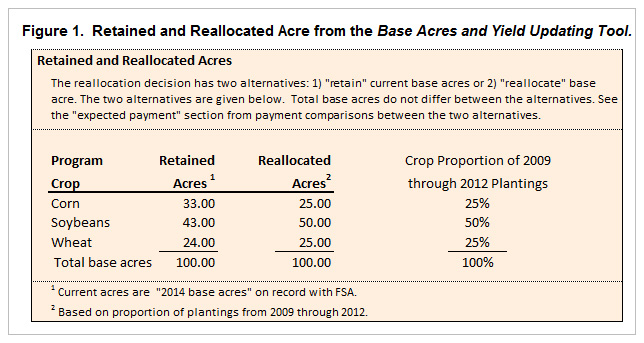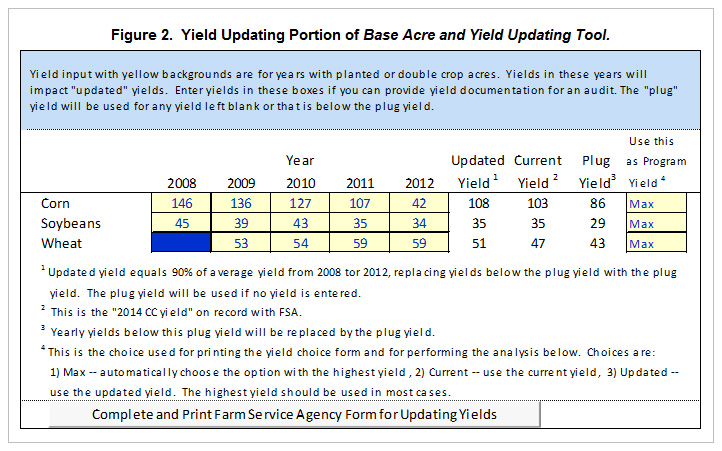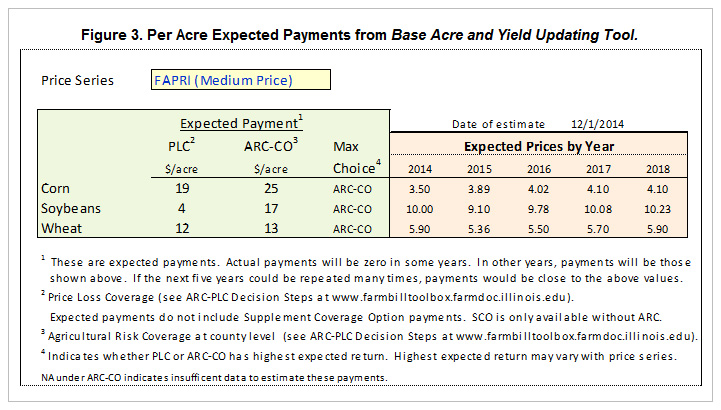Base Acre and Yield Updating Tool: A Release of Spreadsheet to Aid in Making Farm Bill Decisions
The Base Acre and Yield Updating spreadsheet is available on the farmdoc website (see here for download). This tool will aid in making the first two sets of Farm Bill decisions: 1) base acre allocation and 2) yield updating. It also makes comparisons of expected payments from Agricultural Risk Coverage – County Option (ARC-CO) and Price Loss Coverage (PLC) programs calculated by Agricultural Policy Analysis System (see here). The Base Acre and Yield Updating spreadsheet also prints the Farm Service Agency (FSA) form for reporting updated yields.
Program Inputs
The following inputs are needed for a Farm Service Agency (FSA) farm:
- 2014 base acres. These are the current base acres on the farm. These will be the base acres for the farm if acres are not reallocated.
- 2014 CC yields. These yields will be the program yields for determining Price Loss Coverage (PLC) payments, unless yields are updated to 90% of average yields from 2008 through 2012.
- Planted, prevented, double, and subsequent acres for 2008 through 2012. These acres determine a) reallocated base acres by crop and b) whether yields for an individual year enters into yield updating.
This information was sent to each farmer and landowner in a letter from FSA received in August 2014. The spreadsheet includes an example of this information. See the FSA if this letter is no longer available.
Retained and Reallocated Acres
For each FSA farm, there will be two alternatives:
- Keep retained acres – The current acres reported in the August 2014 letter, or
- Relocate base acres – These relocated acres are based on the proportion of plantings in program crops from 2009 through 2012.
Figure 1 shows these alternatives produced by the Base Acre and Yield Updating spreadsheet for a specific southern Illinois farm with 100 base acres. Note that total base acres stay the same between the alternatives, as is always the case. The allocation decisions only changes the allocation to program crops, not the total number of base acres.

The allocation alternative with the highest expected payments usually should be selected. See the “Expected Payments” section below for more discussion.
Yield Updating
The program allows entry of yields needed for updating yields (see Figure 2). For each crop, the choice of yields are:
- Keep the current CC yield as the program yield. This was provided in the August 2014 letter, and
- Update the yield. The updated yield equals 90% of average yields from 2008 through 2012. There may be a plug yield equal to 75% of the 2009-12 average county yield used in the calculation. A plug yield is used if 1) the actual yield is below the plug yield of 2) a yield is not given because documentation cannot be provided. In Figure 2, the actual corn yield of 42 bushels per acre in 2012 would be replaced by the plug yield of 86 bushels per acre.

In general, the highest yield should be select. Different choices can be made for each crop.
Note that these program yields only impact PLC payments under the 2014 Farm Bill. When the updated yields are higher than current yields, we suggest updating yields even if ARC is chosen. These program yields may impact payments from future farm bills.
Once yields are entered, the Base Acre and Yield Updating tool can print form CCC-859, the form used to report yields to FSA. The user will have to indicate the form of documentation for each yield.
Expected Payments
The program also compares expected payments under retained or reallocated base acres using per acre expected payments from APAS (see here). Figure 3 shows the per acre expected payments for PLC and ARC-CO for Randolph County, Illinois.

In Figure 3, PLC has an expected payment of $19 per year. This is an “average” over 2014 through 2018 across many yield and price scenarios. There will be many years in which those payments equal zero. Other years they will be above $19 per acre. If 2014 through 2018 could be repeated many times, the average of the payments would equal these expectations. The actual results over the next five years will vary from these expectations.
Yields used in the calculation are based on county trend yields. There will be many yields used based on historical yield variability. Correlations between prices and yields are maintained when calculating expected payments.
These expected payments are dependent on the price scenario. There are three price scenarios in the Base Acre and Yield Updating spreadsheet:
- USDA – usually the lowest prices,
- FAPRI – a price series often between USDA and CBO prices, and
- CBO – usually the highest prices.
For corn, FAPRI has expected prices of $3.50 in 2014, $3.89 in 2015, $4.02 in 2016, $4.10 in 2017, and $4.10 in 2018 (see Figure 3). Based on historical variability, prices are varied around these expectation. The average equals the price given in Figure 3. For example, the average of price scenarios in 2015 equaled $3.89. Some of the prices are below and some are above $3.89. Some of the prices will be below the reference price of $3.70. As a result, there will be expectations of PLC payments even when the expected price is higher than the reference price.
Based on per acre expected payments, the expected payments for each allocation are calculated (see Figure 4). These payments are given for:
- all program crops are enrolled in PLC,
- all program crops are enrolled in ARC-CO, and
- the program (PLC or ARC-CO) is selected for each crop.

Note that these estimates do not include estimates for Supplemental Coverage Option (SCO), a crop insurance alternative only available with PLC. SCO may provide additional payments not included in estimates.
The expected payments in Figure 4 are based on the FAPRI set of prices. The CBO and USDA prices could result in a different set of rankings. Therefore, comparing payment across the differing price sets is recommended.
We have done many comparisons of expected payments for Midwest farms with corn, soybeans, and wheat. Usually, the allocation with the lowest number of soybean acres results in the highest expected payments, regardless of price series selected.
Summary
This tool will be useful for individuals making base acre and yield updating decisions. More information on these decisions is available in the Farm Bill Toolbox.
Disclaimer: We request all readers, electronic media and others follow our citation guidelines when re-posting articles from farmdoc daily. Guidelines are available here. The farmdoc daily website falls under University of Illinois copyright and intellectual property rights. For a detailed statement, please see the University of Illinois Copyright Information and Policies here.







